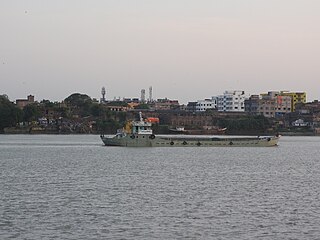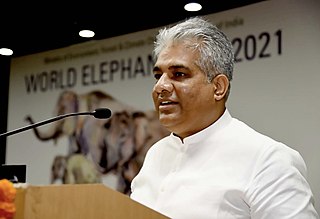
The Rajya Sabha, constitutionally the Council of States is the upper house of the bicameral Parliament of India. As of 2021 it has a maximum membership of 245, of which 233 are elected by the legislatures of the states and union territories using single transferable votes through Open Ballot while the President can appoint 12 members for their contributions to art, literature, science, and social services. The potential seating capacity of the Rajya Sabha is 250, according to article 80 of the Indian Constitution. Members sit for staggered terms lasting six years, with about a third of the 233 designates up for election every two years, in even-numbered years. The Rajya Sabha meets in continuous sessions, and unlike the Lok Sabha, being the lower house of the Parliament, the Rajya Sabha is not subjected to dissolution. However, the Rajya Sabha, like the Lok Sabha can be prorogued by the President.

The Parliament of India is the supreme legislative body of the Republic of India. It is a bicameral legislature composed of the President of India and the two houses: the Rajya Sabha and the Lok Sabha. The President in his role as head of legislature has full powers to summon and prorogue either the House of Parliament or to dissolve the Lok Sabha. The president can exercise these powers only upon the advice of the Prime Minister and his Union Council of Ministers.
This is a brief description of the lawmaking procedure in India.

Sarbananda Sonowal is an Indian politician from Assam who is the current Minister of Ports, Shipping and Waterways and Minister of AYUSH in the Government of India. He is a Member of Parliament in the Rajya Sabha from Assam and also a member of the Cabinet Committee on Political Affairs. He is a former Chief Minister of Assam and a former MLA in Assam Legislative Assembly. Sonowal earlier served as the Assam state President of Bharatiya Janata Party (BJP) from 2012 to 2014 and again in 2015 to 2016. He has also served as the Minister for Sports and Youth Affairs, Government of India, from 2014 to 2016. He was chosen to be the Chief Minister of Assam after the 2016 Assam Legislative Assembly election and he became the first Chief Minister of the state from Bharatiya Janata Party. During the cabinet reshuffle on 7th July 2021, he was inducted to the 2nd Modi Cabinet.

Nitin Jairam Gadkari is an Indian politician from Maharashtra who is the current Minister for Road Transport & Highways in the Government of India. He is also the longest serving Minister for Road Transport & Highways currently running his tenure for over 7 years. Gadkari earlier served as the President of the Bharatiya Janata Party (BJP) from 2009 to 2013. He is also known for his work as the Public Works Department Minister of the State of Maharashtra, where, under his leadership, a series of roads, highways and flyovers across the state were constructed – including the Mumbai-Pune Expressway, India's first six-lane concrete, high-speed expressway. Gadkari is closely associated with the Rashtriya Swayamsevak Sangh (RSS), which is headquartered in his home constituency of Nagpur. He currently represents the Nagpur constituency in the Lok Sabha, and is a lawyer by occupation. During the cabinet reshuffle on 7th July 2021 the portfolio for Ministry of MSME which was under him was reassigned to Narayan Rane, another BJP MP from Maharashtra as a part of cabinet expansion.

The National Waterway 1 (NW-1) or Ganga-Bhagirathi-Hooghly river system is located in India and runs from Prayagraj in Uttar Pradesh to Haldia in West Bengal via Patna and Bhagalpur in Bihar across the Ganges river. It is 1,620 km (1,010 mi) long, making it the longest waterway in India. It is of prime importance amongst all the national waterways considering its locational advantages. The NW-1 passes through West Bengal, Jharkhand, Bihar and Uttar Pradesh and serves major cities and their industrial hinterlands like;
Whistle Blowers Protection Act, 2011 is an Act of the Parliament of India which provides a mechanism to investigate alleged corruption and misuse of power by public servants and also protect anyone who exposes alleged wrongdoing in government bodies, projects and offices. The wrongdoing might take the form of fraud, corruption or mismanagement. The Act will also ensure punishment for false or frivolous complaints.

Bhupender Yadav is an Indian politician who serves as the Union Cabinet Minister of Labour and Employment, Environment, Forest and Climate Change in the Government of India. He is the national general secretary of the Bharatiya Janata Party. He is a Member of Parliament in the Rajya Sabha, representing the state of Rajasthan, a position he has held since 2012. He was reelected in April 2018.
The Andhra Pradesh Reorganisation Act, 2014, commonly known as the Telangana Act, is an Act of Indian Parliament that bifurcated the state of Andhra Pradesh into Telangana and the residuary Andhra Pradesh state, as an outcome of the Telangana movement. The Act defined the boundaries of the two states, determined how the assets and liabilities were to be divided, and laid out the status of Hyderabad as the permanent capital of new Telangana state and temporary capital of the Andhra Pradesh state.
Section 309 of the Indian Penal Code criminalises attempted suicide as well as suicide assistance.
The Insolvency and Bankruptcy Code, 2016 (IBC) is the bankruptcy law of India which seeks to consolidate the existing framework by creating a single law for insolvency and bankruptcy. The Insolvency and Bankruptcy Code, 2015 was introduced in Lok Sabha in December 2015. It was passed by Lok Sabha on 5 May 2016 and by Rajya Sabha on 11 May 2016. The Code received the assent of the President of India on 28 May 2016. Certain provisions of the Act have come into force from 5 August and 19 August 2016. The bankruptcy code is a one stop solution for resolving insolvencies which previously was a long process that did not offer an economically viable arrangement. The code aims to protect the interests of small investors and make the process of doing business less cumbersome. The IBC has 255 sections and 11 Schedules.

The Institutes of Technology Act, 1961 is a legislation in India giving legal status, including degree granting powers, to the Indian Institutes of Technology (IITs). It was notified in the gazette as Act number 59 of 1961 on 20 December 1961 and came into effect on 1 April 1962. The Act also declares these institutes as Institutes of National Importance.
Water transport in India' has played a significant role in the country's overall economy and is indispensable to foreign trade. India is endowed with an extensive network of waterways in the form of rivers, canals, backwaters, creeks and a long coastline accessible through the seas and oceans. It has the largest carrying capacity of any form of transport and is most suitable for carrying bulky goods over long distances. It is one of the most cheap modes of transport in India, as it takes advantage of natural track and does not require huge capital investment in construction and maintenance except in the case of canals. Its fuel efficiency contributes to lower operating costs and reduced environmental impact due to carbon. India has 14500 km of inland waterways. Out of which only 5685 km are navigable by mechanized vessels.
The Repealing and Amending Act, 2016 is an Act of the Parliament of India that repealed 295 Acts, and also made minor amendments to the Sexual Harassment of Women at the Work Place Act, 2013, and the Governors Amendment Act, 2014. The Act was the third such repealing act tabled by the Narendra Modi administration aimed at repealing obsolete laws.
The Repealing and Amending Act, 2017 is an Act of the Parliament of India that repealed 104 Acts, and also partially repealed three sections of the Taxation Laws (Amendment) Act, 2007, and made minor amendments to three other Acts to correct typographical errors. The Act was the fourth such repealing act tabled by the Narendra Modi administration aimed at repealing obsolete laws.
The Repealing and Amending (Second) Act, 2017 is an Act of the Parliament of India that repealed 131 Acts, and also repealed nine Ordinances promulgated by the Governor-General of India before independence. It also made minor amendments to The Plantations Labour Act, 1951, The Juvenile Justice Act, 2015, and The Rights of Persons with Disabilities Act, 2016. The Act was the fifth such repealing act tabled by the Narendra Modi administration aimed at repealing obsolete laws.

The One Hundred and Second Amendment of the Constitution of India, officially known as the Constitution Act, 2018, granted constitutional status to the National Commission for Backward Classes (NCBC).
The Transgender Persons Act, 2019 is an act of the Parliament of India with the objective to provide for protection of rights of transgender people, their welfare, and other related matters. The act was introduced in the Lok Sabha, the lower house of the Parliament, on 19 July 2019 by the Minister of Social Justice and Empowerment, Thawar Chand Gehlot, in light of the lapse of the Transgender Persons Bill, 2018. The 2019 act and the immediately preceding 2018 bill, were both preceded by a 2016 version. They were met with protests and criticism by transgender people, lawyers, and activists in India. The 2016 bill was sent to a standing committee which submitted its report in July 2017. Following this, the Lok Sabha tabled and passed a newer version of the bill in December 2018. However, it did not incorporate many of the committee's recommendations. Although members of the opposition criticised the 2019 act and assured transgender people that they would not vote in favour of it, it was passed by the Lok Sabha on 5 August 2019 and by the Rajya Sabha, the upper house of the Parliament, on 26 November 2019. The president assented to it on 5 December 2019, upon which the act was published in the Gazette of India. It has been in effect since 10 January 2020 following a notification of the same in the Gazette on the same day.
Special Protection Group (Amendment) Act, 2019 is an act passed by Indian parliament in 2019 which reduces Special Protection Group cover to only Prime Minister, former Prime Minister and their immediate family members up to 5 years after ceasing post if they are residing at the residence allotted. The bill amends Special Protection Group Act 1988 which was in application.






